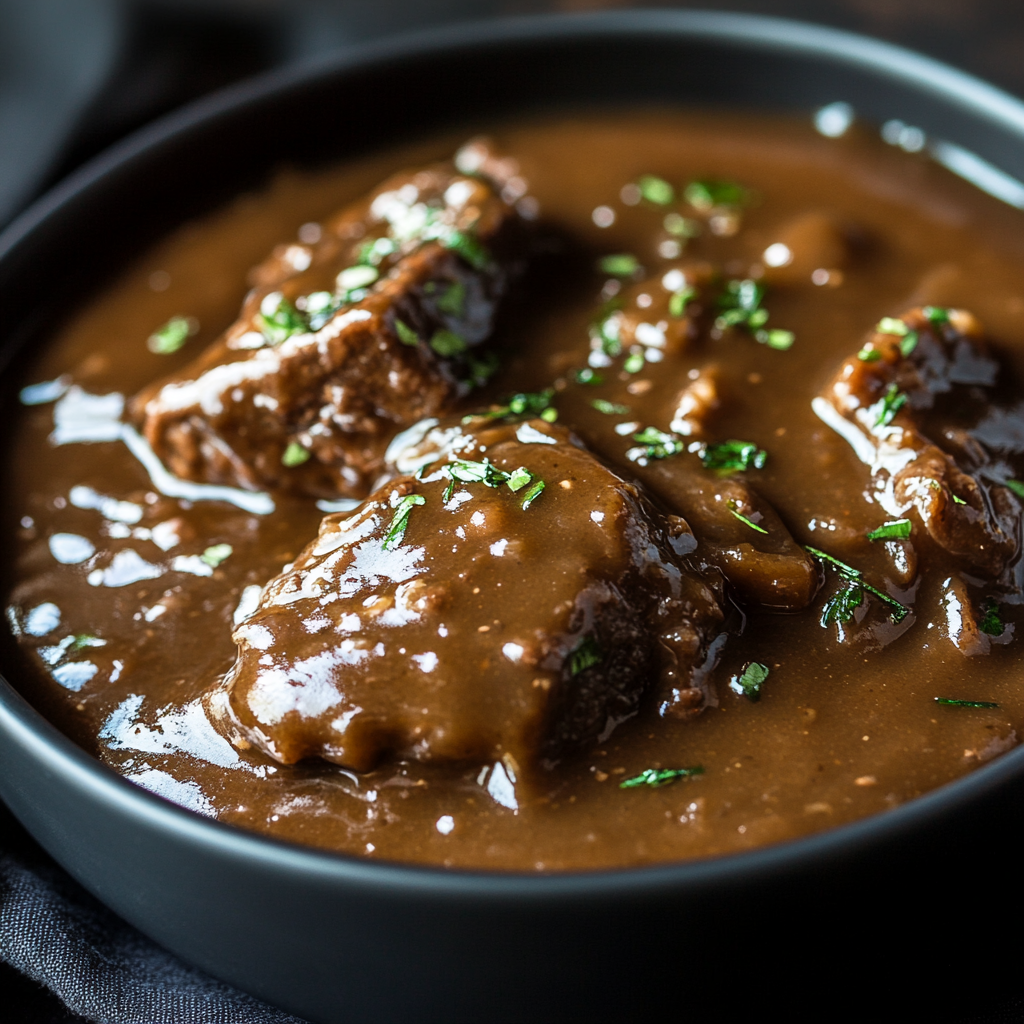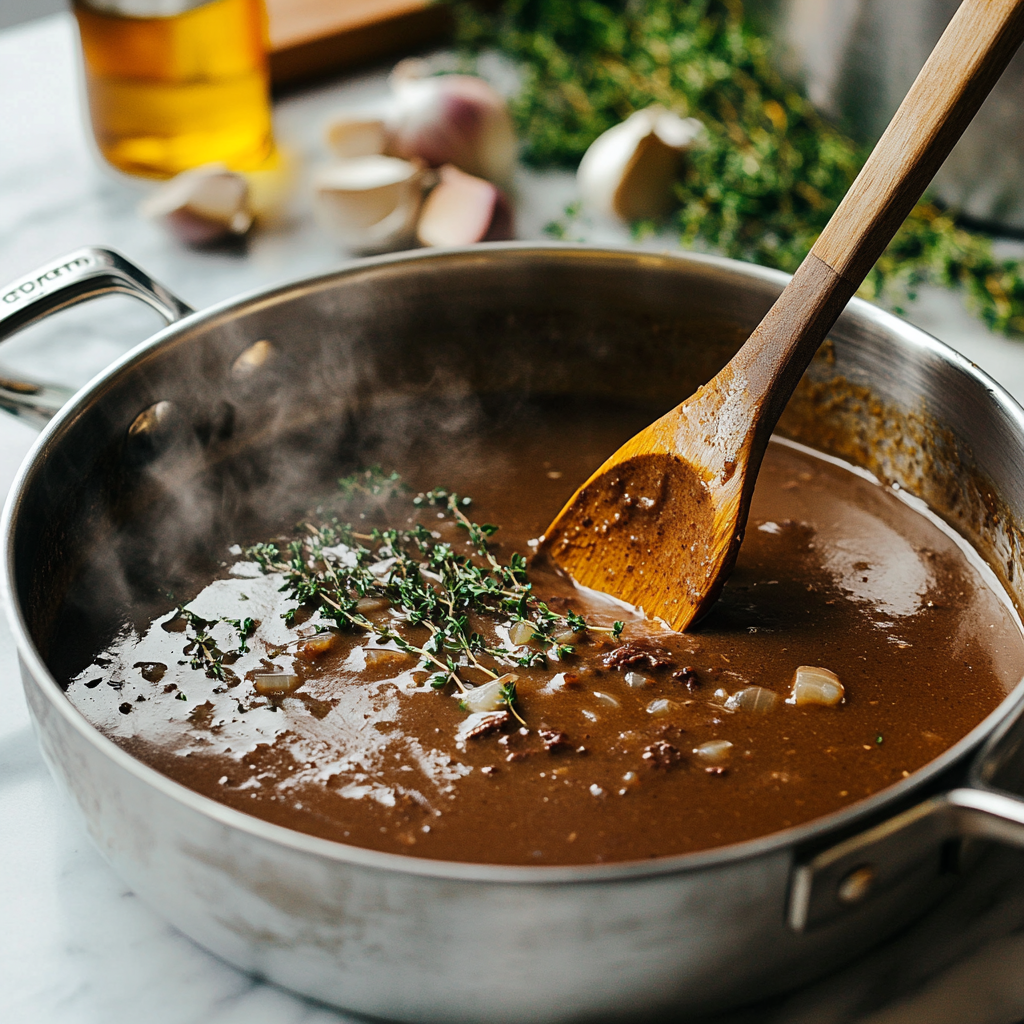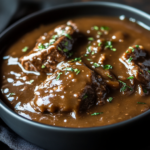
Beef gravy is a timeless staple cherished in both traditional and modern cuisine. Not only is it versatile, but it also enhances the flavor profile of countless dishes. For instance, when draped over a succulent roast or poured generously atop creamy mashed potatoes, this savory sauce can transform a simple meal into a gourmet delight. Moreover, mastering the art of preparing beef gravy from scratch significantly enriches your culinary skills. In addition, it fosters a deeper appreciation for the techniques and flavors that define exceptional cooking. Therefore, incorporating beef gravy into your recipes is a simple yet impactful way to elevate your meals.
Table of Contents
What Is Beef Gravy?
Definition and History of Beef Gravy
Beef gravy is a savory sauce made from beef drippings and broth, often thickened with flour or cornstarch. It is a versatile accompaniment that enhances the flavor of meats, potatoes, vegetables, and other dishes. Known for its rich, hearty taste, beef gravy has become a staple in both traditional and modern cuisines worldwide.
Origins of Beef Gravy in Cuisine
The origins of beef gravy can be traced back to medieval European cooking, where gravies were created from the juices released by roasted or braised meats. Chefs would use these flavorful drippings as a base to craft sauces that complemented the meat. Over time, techniques evolved, and gravies became a cornerstone of hearty meals in countries like England, France, and the United States.
Importance in Traditional and Modern Meals
In traditional meals, beef gravy often serves as a centerpiece, tying together dishes like roast beef, mashed potatoes, and Yorkshire pudding. In modern cuisine, its role has expanded to include gourmet variations, enhanced with a variety of herbs, wines, or mushrooms. Its ability to elevate the dining experience makes it a beloved addition to meals across cultures.
Ingredients Required for Beef Gravy Recipe
Essential Ingredients
- Beef Drippings: Rendered fat and juices collected from cooked beef, which serve as the flavor foundation of the gravy.
- Beef Broth: Enhances the depth of the gravy’s flavor and adds richness to the sauce.
- Flour or Cornstarch: Used as a thickening agent to achieve the desired consistency.
- Butter or Fat: Helps to blend and enrich the gravy, giving it a smooth texture.
Optional Add-ins for Flavor
To customize the gravy’s taste, optional ingredients can be added:
- Herbs: Thyme, rosemary, or parsley provide aromatic freshness.
- Spices: Black pepper, garlic powder, or paprika add complexity and heat.
- Aromatics: Sautéed onions, garlic, or shallots deepen the flavor profile.
- Liquids: A splash of red wine, Worcestershire sauce, or cream can enhance richness and character.
Beef gravy’s adaptability makes it a kitchen staple, offering endless possibilities for flavor variations while maintaining its core appeal.
Kitchen Tools Needed for Beef Gravy
Basic Tools
- Saucepan: A medium-sized saucepan is essential for simmering the gravy and ensuring even heat distribution.
- Whisk: A whisk helps to blend the flour or cornstarch with the liquid, preventing lumps and creating a smooth consistency.
- Measuring Cups and Spoons: These ensure accurate proportions of ingredients for a perfectly balanced flavor.
Advanced Equipment for Perfect Texture
- Gravy Separator: This tool separates fat from meat juices, allowing for a leaner gravy with a cleaner taste.
- Immersion Blender: Ideal for blending in aromatics or creating a silky texture, especially if you’ve added sautéed vegetables to the mix.
Preparing the Beef Base for Gravy
Selecting Quality Beef
The foundation of great beef gravy lies in the quality of the beef you choose. Opt for cuts that produce rich, flavorful drippings when roasted or seared.
- Best Cuts for Drippings: Ribeye, chuck roast, sirloin, or brisket are excellent choices due to their marbling and juice content.
- Beef Bones for Broth: Using marrow-rich bones, such as knucklebones or shanks, can create an even deeper, more robust flavor for your gravy base.
Tips for Cooking Beef to Maximize Flavor
- Searing: Start by searing the beef over high heat to caramelize the exterior. This process, known as the Maillard reaction, enhances the drippings’ flavor.
- Roasting: Cook the beef in the oven on a rack to allow drippings to collect in the pan below, ensuring a concentrated base for the gravy.
- Deglazing: After cooking, deglaze the pan with broth, wine, or water to scrape up the flavorful browned bits (fond) stuck to the pan. This liquid is a crucial component of the gravy.
- Seasoning: Lightly season the beef before cooking, but avoid over-salting. This ensures the drippings are flavorful yet versatile for creating the gravy.
With the right tools and techniques, you can craft a rich, flavorful beef gravy that perfectly complements your meal.
The Science Behind Thickening Agents
Common Thickening Agents
- Flour: A classic choice, flour is often used to make a roux (a mixture of fat and flour cooked together). It thickens the gravy and adds a subtle, nutty flavor.
- Cornstarch: A starch-based thickener that provides a glossy, smooth texture. It requires mixing with cold water or broth (a slurry) before being added to the gravy to prevent clumping.
- Alternatives:
- Arrowroot Powder: Works similarly to cornstarch but is suitable for gluten-free diets and gives a clearer finish.
- Potato Starch: Provides a rich texture and is another gluten-free option.
- Xanthan Gum: A modern thickener requiring very small amounts to achieve consistency.
Balancing Consistency and Flavor
The goal is to thicken the gravy while maintaining its robust flavor:
- Use the thickening agent sparingly to avoid an overly dense or pasty texture.
- Gradually incorporate the agent to ensure the desired consistency without over-thickening.
- Adjust flavors after thickening, as some agents can slightly alter the taste or texture.
Step-by-Step Beef Gravy Recipe

Preparation Steps
- Collecting Beef Drippings:
- After cooking beef, pour the drippings from the pan into a bowl or a gravy separator to remove excess fat. Retain the flavorful juices for the base.
- If needed, deglaze the pan with a splash of beef broth, water, or wine to collect the browned bits (fond).
- Making Beef Broth:
- Simmer beef bones, aromatics (onion, garlic, carrot, celery), and herbs (thyme, bay leaf) in water for several hours. Strain the broth to use as a flavorful liquid for the gravy.
Cooking the Gravy
- Making the Roux (if using flour):
- Heat 2 tablespoons of fat (from drippings or butter) in a saucepan over medium heat.
- Add 2 tablespoons of flour and whisk continuously for 2–3 minutes until the mixture turns golden brown.
- Incorporating the Liquid:
- Gradually pour 2 cups of beef broth into the saucepan, whisking constantly to prevent lumps.
- Add the reserved beef drippings for additional flavor.
- Thickening with Cornstarch or Alternatives (if not using a roux):
- Dissolve 1 tablespoon of cornstarch in 2 tablespoons of cold water. Slowly whisk the slurry into the simmering gravy.
- Continue whisking until the desired thickness is achieved.
- Simmering and Adjusting Flavors:
- Lower the heat and let the gravy simmer for 5–10 minutes, stirring occasionally.
- Taste and adjust with salt, pepper, or additional seasonings (e.g., Worcestershire sauce, garlic powder).
- Finishing Touches:
- If desired, blend in optional ingredients like sautéed onions or a splash of cream for richness.
- Strain the gravy through a fine mesh sieve for a velvety texture.
Serve your homemade beef gravy warm, drizzled over roast beef, mashed potatoes, or any dish that needs a flavorful boost!
Variations of Beef Gravy Recipe
Classic Beef Gravy
Traditional Techniques and Additions:
- Base Ingredients: Classic beef gravy is made using beef drippings, broth, flour, and seasonings like salt, pepper, and thyme.
- Preparation: A roux is created by combining the drippings with flour, then gradually whisking in beef broth.
- Additions:
- A splash of Worcestershire sauce adds depth.
- A hint of garlic powder or onion powder enhances the flavor without overpowering the traditional taste.
Gourmet Beef Gravy
Red Wine Variation:
- Deglaze the pan with ½ cup of dry red wine after cooking the beef.
- Simmer the wine until reduced by half, then add beef broth and drippings.
- Incorporate a roux or cornstarch slurry and finish with fresh rosemary or thyme for an upscale flavor.
Mushroom Variation:
- Sauté sliced mushrooms in butter or drippings until golden brown.
- Add beef broth and drippings, then thicken with a roux or cornstarch slurry.
- Finish with a splash of cream for richness (optional) and season with black pepper and fresh parsley.
Garlic Variation:
- Roast whole garlic cloves until soft, then mash them into a paste.
- Add the garlic paste to the simmering gravy for a deep, caramelized garlic flavor.
- Enhance with a splash of balsamic vinegar for complexity.
Dairy-Free and Gluten-Free Options
Dairy-Free Beef Gravy:
- Replace butter with olive oil or a neutral-flavored plant-based margarine.
- Use cornstarch, arrowroot, or potato starch as a thickening agent instead of a flour-based roux.
- Season with nutritional yeast for a slightly cheesy, savory note.
Gluten-Free Beef Gravy:
- Substitute all-purpose flour with gluten-free flour or starch (e.g., arrowroot or rice flour) to thicken.
- Ensure that broth and any additional ingredients (like Worcestershire sauce) are gluten-free.
- Add flavor-enhancing elements like tamari (a gluten-free soy sauce) or herbs to round out the taste.
These variations cater to a range of tastes and dietary preferences, ensuring everyone can enjoy this comforting and versatile sauce. Experiment with different ingredients to find the perfect balance for your dish!
Common Mistakes to Avoid When Making Beef Gravy
Over-Thickening or Under-Thickening
- Over-Thickening: Adding too much thickening agent (flour, cornstarch, etc.) can result in a gravy that is too dense and pasty.
- Fix: Start with small amounts of thickener and add gradually. If the gravy becomes too thick, thin it out with a bit more broth or water until the desired consistency is reached.
- Under-Thickening: On the other hand, if the gravy is too thin, it won’t have the rich, satisfying texture that a proper gravy should.
- Fix: Mix a small amount of cornstarch or flour with cold liquid (a slurry) and whisk it into the simmering gravy. Allow it to cook for a few minutes until it thickens to the desired level.
Flavor Balance Issues
- Too Salty: If you’ve over-seasoned or used a salty broth, your gravy can become too salty.
- Fix: Dilute the gravy with additional broth or water. Add a small amount of sugar to balance out the saltiness or incorporate a splash of vinegar or lemon juice to add brightness and cut the salt.
- Bland Gravy: If the gravy lacks depth or richness, it may be missing key flavor components.
- Fix: Add more seasoning such as black pepper, garlic powder, or a dash of Worcestershire sauce. For deeper flavor, incorporate a small amount of soy sauce or red wine. Simmer the gravy longer to allow flavors to meld.
Fixing Lumpy Gravy
- Lumpy Gravy: This can happen if flour or cornstarch isn’t properly mixed into the liquid before cooking.
- Fix: If lumps form, you can use a whisk to break them up. Alternatively, pour the gravy through a fine mesh sieve to strain out the lumps. If needed, use an immersion blender for a smoother texture.
Storing and Reheating Beef Gravy
Proper Storage Techniques
- Refrigeration:
- Store leftover beef gravy in an airtight container. Allow it to cool to room temperature before placing it in the fridge to avoid condensation.
- Beef gravy will keep for up to 3–4 days in the refrigerator.
- Freezing:
- Beef gravy can be frozen for longer storage (up to 3 months).
- Let the gravy cool completely before transferring it to a freezer-safe container. If desired, portion it into smaller servings for easier thawing.
- Label the container with the date to track how long it’s been frozen.
Best Practices for Reheating
- Microwave:
- To reheat in the microwave, place the gravy in a microwave-safe bowl and cover it loosely with a lid or microwave-safe plastic wrap.
- Heat in 30-second intervals, stirring in between to ensure even heating and to prevent the gravy from becoming too thick. Add a splash of broth or water if it has thickened too much.
- Stovetop:
- Reheat the gravy in a saucepan over low to medium heat, stirring frequently to prevent it from scorching.
- If the gravy has thickened during storage, add a small amount of broth or water to achieve the desired consistency.
- Oven:
- Preheat the oven to 325°F (163°C). Place the gravy in an oven-safe dish and cover with foil.
- Heat for about 20–30 minutes, stirring once or twice during the reheating process. Add liquid as needed to restore the gravy’s texture.
By following these storage and reheating methods, you can ensure that your beef gravy stays flavorful and smooth for future use, allowing you to enjoy it again without compromising quality.
Pairing Beef Gravy with Dishes
Ideal Main Dishes
- Roast Beef: The classic pairing, beef gravy enhances the flavor of succulent roast beef, making it a quintessential comfort food.
- Mashed Potatoes: Creamy mashed potatoes are the perfect base for a generous drizzle of beef gravy, creating a rich, satisfying side dish.
- Yorkshire Pudding: This traditional British pairing features beef gravy poured over light, airy Yorkshire pudding for a timeless combination.
Unique Pairings
- Sandwiches: Use beef gravy as a dip for roast beef sandwiches or open-faced hot beef sandwiches for added moisture and flavor.
- Meatloaf: Serve beef gravy alongside or over meatloaf to elevate this hearty dish.
- Fries: Beef gravy is a key ingredient in dishes like poutine, where it smothers fries and cheese curds to create a savory, indulgent treat.
Nutritional Information of Beef Gravy Recipe
Calorie Breakdown
The calorie content of beef gravy can vary depending on the ingredients:
- Standard Recipe (per ¼ cup serving):
- Calories: ~50–70
- Fat: 3–5g (depending on the amount of drippings or butter used)
- Carbohydrates: 4–6g (from thickening agents like flour or cornstarch)
- Protein: ~1–2g
Macronutrients and Sodium Content
- Macronutrients:
- Fat content can be reduced by separating fat from drippings.
- Carbs are minimal, making it suitable for moderate carb diets.
- Sodium: Beef broth and drippings can contribute significant sodium levels. Use low-sodium broth or homemade alternatives to control this.
Healthier Alternatives
- Lower-Calorie Ingredients: Replace butter with olive oil or reduce the quantity of drippings.
- Thickening Agents: Use cornstarch or arrowroot in smaller amounts compared to flour for fewer calories.
- Sodium Reduction: Use no-salt-added broth and season with herbs or garlic for flavor without extra salt.
Cultural Significance of Beef Gravy
Beef Gravy Across Different Cuisines
- British Cuisine: Beef gravy is a cornerstone of traditional British meals, especially Sunday roasts. Paired with Yorkshire pudding and vegetables, it symbolizes hearty, home-cooked comfort.
- American Cuisine: In the U.S., beef gravy is a popular addition to meatloaf, mashed potatoes, and hot sandwiches. It also features in dishes like biscuits and gravy in its variations.
- Other Influences: Beef gravy has adaptations in other cuisines. For example, in Canadian cuisine, it is a key component of poutine, while in European countries, it is often infused with wine or cream for a gourmet twist.
Festive and Everyday Uses
- Festive Meals: Beef gravy plays a starring role in holiday meals like Christmas and Thanksgiving, where it accompanies roasted meats and stuffing.
- Everyday Comfort Food: Beyond special occasions, beef gravy is a staple of comfort food, bringing warmth and satisfaction to simple weeknight dinners.
By understanding its cultural roots and versatile pairings, beef gravy becomes more than just a sauce—it’s a flavorful tradition with a place on plates around the world.
Final Thoughts
Beef gravy is a timeless accompaniment that transforms any dish into a comforting, flavorful experience. By using quality ingredients and following simple techniques, you can create a sauce that elevates your meals. For even more inspiration, explore related recipes and beef guides on our website.
Further Reading:
Dive into the art of beef cooking and bring your meals to life!
Frequently Asked Questions (FAQs)
Best Beef Cuts for Gravy
- Question: What are the best beef cuts for making gravy?
Answer: Cuts like chuck roast, ribeye, brisket, and sirloin provide flavorful drippings that are ideal for making beef gravy. These cuts have good marbling, which enhances the taste of the gravy.
How to Fix Common Gravy Issues
- Question: How do I fix lumpy gravy?
Answer: Strain the gravy through a fine mesh sieve or use an immersion blender to smooth out the lumps. Whisking consistently while cooking also helps prevent lumps. - Question: How do I fix gravy that is too salty?
Answer: Dilute it with additional broth or water. Adding a small amount of sugar or vinegar can also balance out the saltiness.
Gluten-Free and Vegan Modifications
- Question: Can I make gluten-free beef gravy?
Answer: Yes! Replace flour with cornstarch, arrowroot, or potato starch as a thickener. Ensure that any broth used is also gluten-free. - Question: How do I make vegan “beef” gravy?
Answer: Use vegetable broth instead of beef broth and replace drippings with olive oil or plant-based margarine. Add soy sauce, nutritional yeast, and mushrooms to replicate the rich, savory flavor.
Can You Make Beef Gravy Without Drippings?
- Question: Can I make beef gravy without pan drippings?
Answer: Absolutely! Use beef broth as the base and enrich the flavor with butter, garlic, onion, and herbs. You can also use a bouillon cube or concentrate for added depth.
What’s the Best Way to Store Beef Gravy?
- Question: How do I store leftover gravy?
Answer: Store in an airtight container in the refrigerator for up to 3–4 days or freeze for up to 3 months. Reheat gently, adding a splash of broth to restore the consistency.
How to Prevent Gravy from Splitting?
- Question: How do I prevent my gravy from splitting?
Answer: Gradually add liquid to the roux and whisk continuously to ensure the fat and liquid emulsify properly. Simmer gently and avoid boiling once the gravy has thickened.
Conclusion
Summarizing the Art of Beef Gravy
Beef gravy is a timeless culinary staple that enhances both traditional and modern dishes. Whether you’re serving it over a hearty roast or using it as a dip for sandwiches, mastering the basics will elevate your cooking.
Key Tips for Perfecting the Recipe
- Start with quality ingredients, like flavorful drippings and good-quality broth.
- Whisk consistently to achieve a smooth, lump-free texture.
- Experiment with variations, such as red wine or mushroom additions, to tailor the gravy to your taste.
- Store and reheat properly to enjoy leftovers without compromising quality.
By following these steps and addressing common issues, you can confidently create a delicious beef gravy that’s rich, flavorful, and perfectly suited to any meal.
Beef Gravy Recipe
Equipment
- Saucepan
- Whisk
- Measuring Cups and Spoons
- Gravy Separator
- Immersion Blender
Ingredients
Beef Drippings
- 2 tablespoons beef drippings from cooked beef
- 2 cups beef broth
- 2 tablespoons flour for roux
- 1 tablespoon cornstarch optional thickening agent
- 1 teaspoon black pepper
- 1 teaspoon salt
- 1 bay leaf bay leaf optional for flavor
- 1 teaspoon thyme optional for flavor
Instructions
- Collect beef drippings from cooked beef and pour into a bowl or gravy separator.
- Heat 2 tablespoons of fat in a saucepan over medium heat. Add 2 tablespoons of flour and whisk continuously for 2-3 minutes until golden brown.
- Gradually pour 2 cups of beef broth into the saucepan, whisking constantly to prevent lumps. Add reserved beef drippings for additional flavor.
- If using cornstarch, dissolve 1 tablespoon in 2 tablespoons of cold water. Slowly whisk the slurry into the simmering gravy and continue whisking until desired thickness is achieved.
- Lower the heat and let the gravy simmer for 5-10 minutes, stirring occasionally. Taste and adjust with salt, pepper, or additional seasonings as needed.
- Blend in optional ingredients like sautéed onions or cream for richness. Strain the gravy through a fine mesh sieve for a velvety texture.

